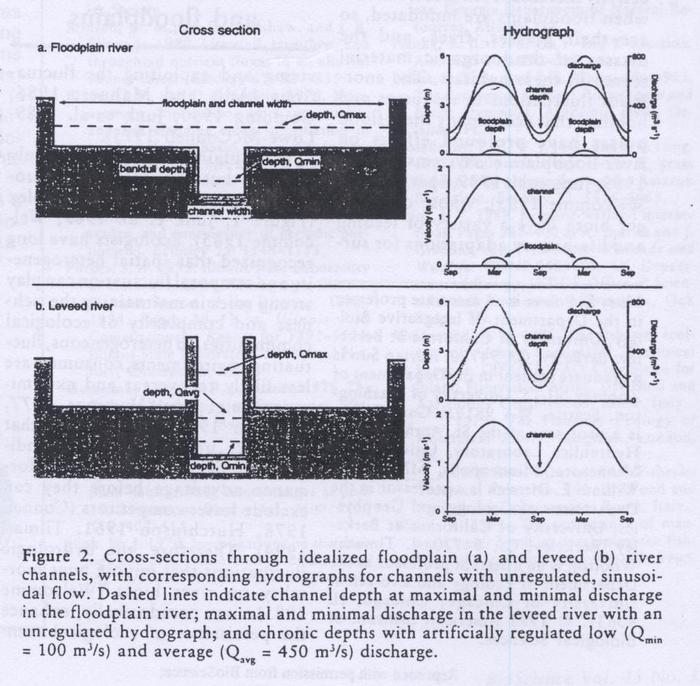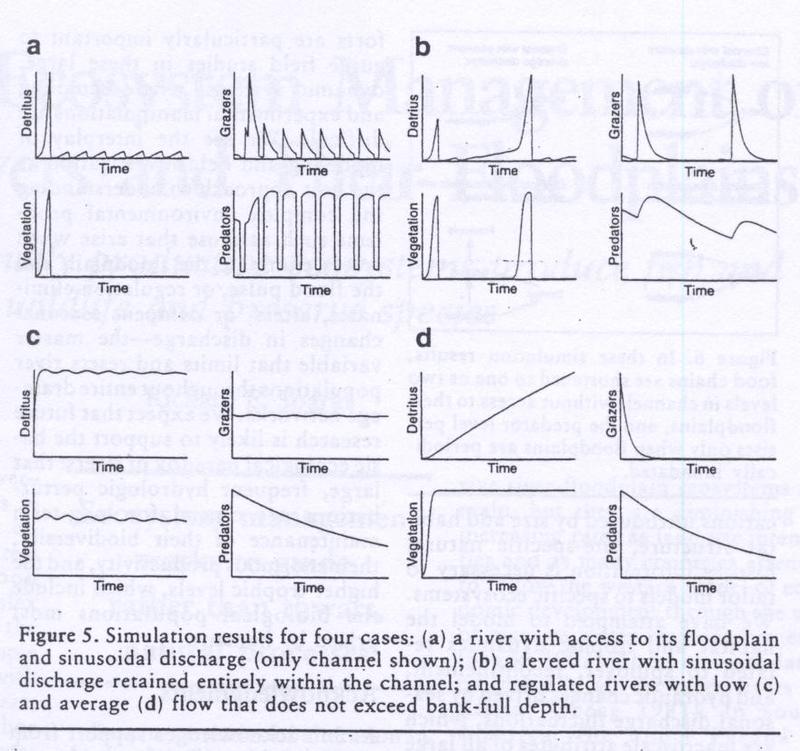|
- The hydraulic geometry of rivers has been described by Leopold and Maddock (at-a-station and downstream relations).
- Equations for biomass dynamics of each of the four trophic elements are tied to channel hydraulics (width, depth and velocity).
- Detritus increases as litter falls.
- Detritus is lost to grazers at a rate determined by their densities (detritus and grazers).
- Detritus diminishes as carbon is respired to the atmosphere as carbon dioxide.
- Outwash (outflow) is assumed to be equal to inwash (inflow).
- Vegetation renews by logistic growth until it becomes self-limiting.
- Vegetation that dies without being grazed increases the detritus.
- Grazers convert vegetation or detritus into offsprings.
- Grazers are killed by predators or die from other causes.
- Predators suffer only non-predatory mortality.
- Human fishing may add another trophic level.
|
LINKAGE OF HYDRAULIC AND TROPHIC DYNAMICS
|
- One-dimensional model portrays large-river hydraulic and trophic dynamics at a single cross-section.
- The model emphasizes temporal dynamics rather than spatial heterogeneity.
- An overview of causal linkages is shown in Fig. 4.
- Local geomorphology determines floodplain width.
- Climate and land use (and geomorphology) govern discharge amount.
- Width, depth, and velocity vary with discharge.
- Width, depth amd velocity influence trophic dynamics by affecting key parameters in the biomass balance equations.
- Table 1 shows biomass balance equations.
- Mobile grazers and predators occupy the floodplain only when water is deeper than 0.2 m.
- This depth has been found to be a critical threshold below which larger prey are vulnerable to fishing birds.
- As hydrograph recedes, mobile grazers and predators return to the main channel except for that fraction left stranded in the flood plain.
- Mortality from stranding can be high.
- In the Parana river, Argentina, mortality by stranding is four times greater than fishing.
- Trophic parameters can be linked to hydraulic parameters.
- Loss rate of detritus decreases with increasing depth because water temperature and microbial concentrations decrease as depth increases.
- Vegetation carrying capacity should decrease with depth if vegetation is light-limited.
- Above a certain velocity, local growth is reduced by sloughing, or by light limitation if high flows are turbid.
- Predator attack rates on grazers might decrease with velocity because of constraints on prey encounter or handling.
- Prey refuges in the main channel can be dislodged by high flows.
- Prey are washed away when flows exceed 2 m/s.
- Results from simulations are shown in Fig. 5.
- The unmodified flood plain (a) maintains the most stable populations at higher trophic levels.
- In the leveed channel (b), predators initially increase only to bust later to unsustainable feed rates.
- In regulated channels with low flow (c), grazers thrive, but they are not able to sustain a viable predator population.
- In regulated channels with average flow (d), flows are chronically too high for the nonhydrodynamic grazers to feed effectively,
and they starve, following by the crash in their predator's population.
- Simulations suggest that the longest food chains are maintained only when the environment fluctuates (the flood pulse).
- Biota do not tract hydrologic cycles.
- Longer, biologically driven cycles can be superimposed on the hydrologic cycle.
|



